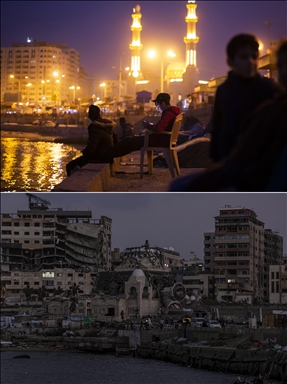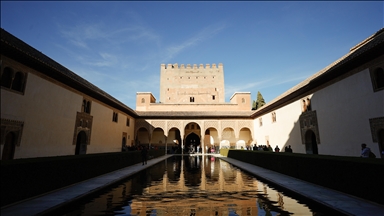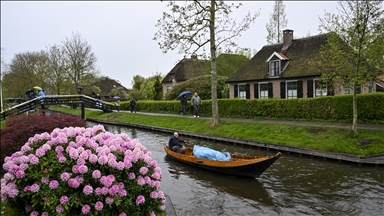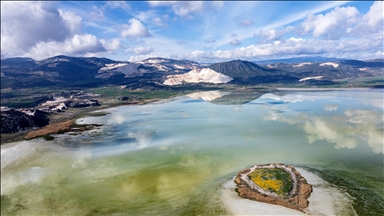
REYKJAVIK, ICELAND - FEBRUARY 23: An aerial view shows the Vatnajokull glaciers meeting the mainland are melting into the ocean or forming lagoons due to global warming and climate change, which is located about 200 km south of the capital Reykjavík, Iceland on February 23, 2025. Iceland, located between Europe and Greenland, has the largest glacier masses in Europe, covering about 10% of its land. ( Evrim Aydın - Anadolu Agency )

REYKJAVIK, ICELAND - FEBRUARY 23: An aerial view shows the Vatnajokull glaciers meeting the mainland are melting into the ocean or forming lagoons due to global warming and climate change, which is located about 200 km south of the capital Reykjavík, Iceland on February 23, 2025. Iceland, located between Europe and Greenland, has the largest glacier masses in Europe, covering about 10% of its land. ( Evrim Aydın - Anadolu Agency )

REYKJAVIK, ICELAND - FEBRUARY 23: An aerial view shows the Vatnajokull glaciers meeting the mainland are melting into the ocean or forming lagoons due to global warming and climate change, which is located about 200 km south of the capital Reykjavík, Iceland on February 23, 2025. Iceland, located between Europe and Greenland, has the largest glacier masses in Europe, covering about 10% of its land. ( Evrim Aydın - Anadolu Agency )

REYKJAVIK, ICELAND - FEBRUARY 23: An aerial view shows the Vatnajokull glaciers meeting the mainland are melting into the ocean or forming lagoons due to global warming and climate change, which is located about 200 km south of the capital Reykjavík, Iceland on February 23, 2025. Iceland, located between Europe and Greenland, has the largest glacier masses in Europe, covering about 10% of its land. ( Evrim Aydın - Anadolu Agency )

REYKJAVIK, ICELAND - FEBRUARY 23: An aerial view shows the Vatnajokull glaciers meeting the mainland are melting into the ocean or forming lagoons due to global warming and climate change, which is located about 200 km south of the capital Reykjavík, Iceland on February 23, 2025. Iceland, located between Europe and Greenland, has the largest glacier masses in Europe, covering about 10% of its land. ( Evrim Aydın - Anadolu Agency )

REYKJAVIK, ICELAND - FEBRUARY 23: An aerial view shows the Vatnajokull glaciers meeting the mainland are melting into the ocean or forming lagoons due to global warming and climate change, which is located about 200 km south of the capital Reykjavík, Iceland on February 23, 2025. Iceland, located between Europe and Greenland, has the largest glacier masses in Europe, covering about 10% of its land. ( Evrim Aydın - Anadolu Agency )

REYKJAVIK, ICELAND - FEBRUARY 23: An aerial view shows the Vatnajokull glaciers meeting the mainland are melting into the ocean or forming lagoons due to global warming and climate change, which is located about 200 km south of the capital Reykjavík, Iceland on February 23, 2025. Iceland, located between Europe and Greenland, has the largest glacier masses in Europe, covering about 10% of its land. ( Evrim Aydın - Anadolu Agency )

REYKJAVIK, ICELAND - FEBRUARY 23: An aerial view shows the Vatnajokull glaciers meeting the mainland are melting into the ocean or forming lagoons due to global warming and climate change, which is located about 200 km south of the capital Reykjavík, Iceland on February 23, 2025. Iceland, located between Europe and Greenland, has the largest glacier masses in Europe, covering about 10% of its land. ( Evrim Aydın - Anadolu Agency )

REYKJAVIK, ICELAND - FEBRUARY 23: An aerial view shows the Vatnajokull glaciers meeting the mainland are melting into the ocean or forming lagoons due to global warming and climate change, which is located about 200 km south of the capital Reykjavík, Iceland on February 23, 2025. Iceland, located between Europe and Greenland, has the largest glacier masses in Europe, covering about 10% of its land. ( Evrim Aydın - Anadolu Agency )

REYKJAVIK, ICELAND - FEBRUARY 23: An aerial view shows the Vatnajokull glaciers meeting the mainland are melting into the ocean or forming lagoons due to global warming and climate change, which is located about 200 km south of the capital Reykjavík, Iceland on February 23, 2025. Iceland, located between Europe and Greenland, has the largest glacier masses in Europe, covering about 10% of its land. ( Evrim Aydın - Anadolu Agency )

REYKJAVIK, ICELAND - FEBRUARY 23: An aerial view shows the Vatnajokull glaciers meeting the mainland are melting into the ocean or forming lagoons due to global warming and climate change, which is located about 200 km south of the capital Reykjavík, Iceland on February 23, 2025. Iceland, located between Europe and Greenland, has the largest glacier masses in Europe, covering about 10% of its land. ( Evrim Aydın - Anadolu Agency )

REYKJAVIK, ICELAND - FEBRUARY 23: An aerial view shows the Vatnajokull glaciers meeting the mainland are melting into the ocean or forming lagoons due to global warming and climate change, which is located about 200 km south of the capital Reykjavík, Iceland on February 23, 2025. Iceland, located between Europe and Greenland, has the largest glacier masses in Europe, covering about 10% of its land. ( Evrim Aydın - Anadolu Agency )

REYKJAVIK, ICELAND - FEBRUARY 23: An aerial view shows the Vatnajokull glaciers meeting the mainland are melting into the ocean or forming lagoons due to global warming and climate change, which is located about 200 km south of the capital Reykjavík, Iceland on February 23, 2025. Iceland, located between Europe and Greenland, has the largest glacier masses in Europe, covering about 10% of its land. ( Evrim Aydın - Anadolu Agency )
































